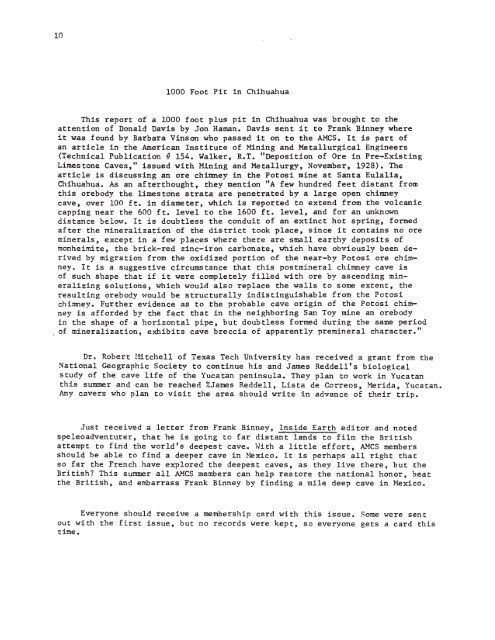asscciation for mexican cave studies box 7672 ut station austin ...
asscciation for mexican cave studies box 7672 ut station austin ...
asscciation for mexican cave studies box 7672 ut station austin ...
- No tags were found...
Create successful ePaper yourself
Turn your PDF publications into a flip-book with our unique Google optimized e-Paper software.
101000 Foot Pit in ChihuahuaThis report of a 1000 foot plus pit in Chihuahua was brought to theattention of Donald Davis by Jon Haman. Davis sent it to Frank Binney whereit was found by Barbara Vinson who passed it on to the AMCS. It is part ofan article in the American Instit<strong>ut</strong>e of Mining and Metallurgical Engineers(Technical Publication n 154. Walker, R.T. "Deposition of are in Pre-ExistingLimestone Caves," issued with Mining and Metallurgy, November, 1928). Thearticle is discussing an ore chimney in the Potosi mine at Santa Eulalia,Chihuahua. As an afterthought, they mention "A few hundred feet distant fromthis orebody the limestone strata are penetrated by a large open chimney<strong>cave</strong>, over 100 ft. in diameter, which is reported to extend from the volcaniccapping near the 600 ft. level to the 1600 ft. level, and <strong>for</strong> an unknowndistance below. It is doubtless the conduit of an extinct hot spring, <strong>for</strong>medafter the mineralization of the district took place, since it contains no oreminerals, except in a few places where there are small earthy deposits ofmonheimite, the brick-red zinc-iron carbonate, which have obviously been derivedby migration from the oxidized portion of the near-by Potosi ore chimney.It is a suggestive circumstance that this postmineral chimney <strong>cave</strong> isof such shape that if it were completely filled with ore by ascending mineralizingsol<strong>ut</strong>ions, which would also replace the walls to some extent, theresulting orebody would be structurally indistinguishable from the Potosichimney. Further evidence as to the probable <strong>cave</strong> origin of the Potosi chimneyis af<strong>for</strong>ded by the fact that in the neighboring San Toy mine an orebodyin the shape of a horizontal pipe, b<strong>ut</strong> doubtless <strong>for</strong>med during the same periodof mineralization, exhibits <strong>cave</strong> breccia of apparently premineral character."Dr. Robert !'litchell of Texas Tech University has received a grant from theNational Geographic Society to continue his and James Reddell's biologicalstudy of the <strong>cave</strong> life of the Yucatan peninsula. They plan to work in Yucatanthis summer and can be reached %James Reddell, Lista de Correos, Merida, Yucatan.Any <strong>cave</strong>rs who plan to visit the area should write in advance of their trip.Just received a letter from Frank Binney, Inside Earth editor and notedspeleoadventurer, that he is going to far distant lands to film the Britishattempt to find the world's deepest <strong>cave</strong>. With a little ef<strong>for</strong>t, AMCS membersshould be able to find a deeper <strong>cave</strong> in ~~xico. It is perhaps all right thatso far the French have explored the deepest <strong>cave</strong>s, as they live there, b<strong>ut</strong> theBritish? This summer all AMes members can help restore the national honor, beatthe British, and embarrass Frank Binney by finding a mile deep <strong>cave</strong> in Mexico.Everyone should receive a membership card with this issue. Some were sento<strong>ut</strong> with the first issue, b<strong>ut</strong> no records were kept, so everyone gets a card thistime.
















